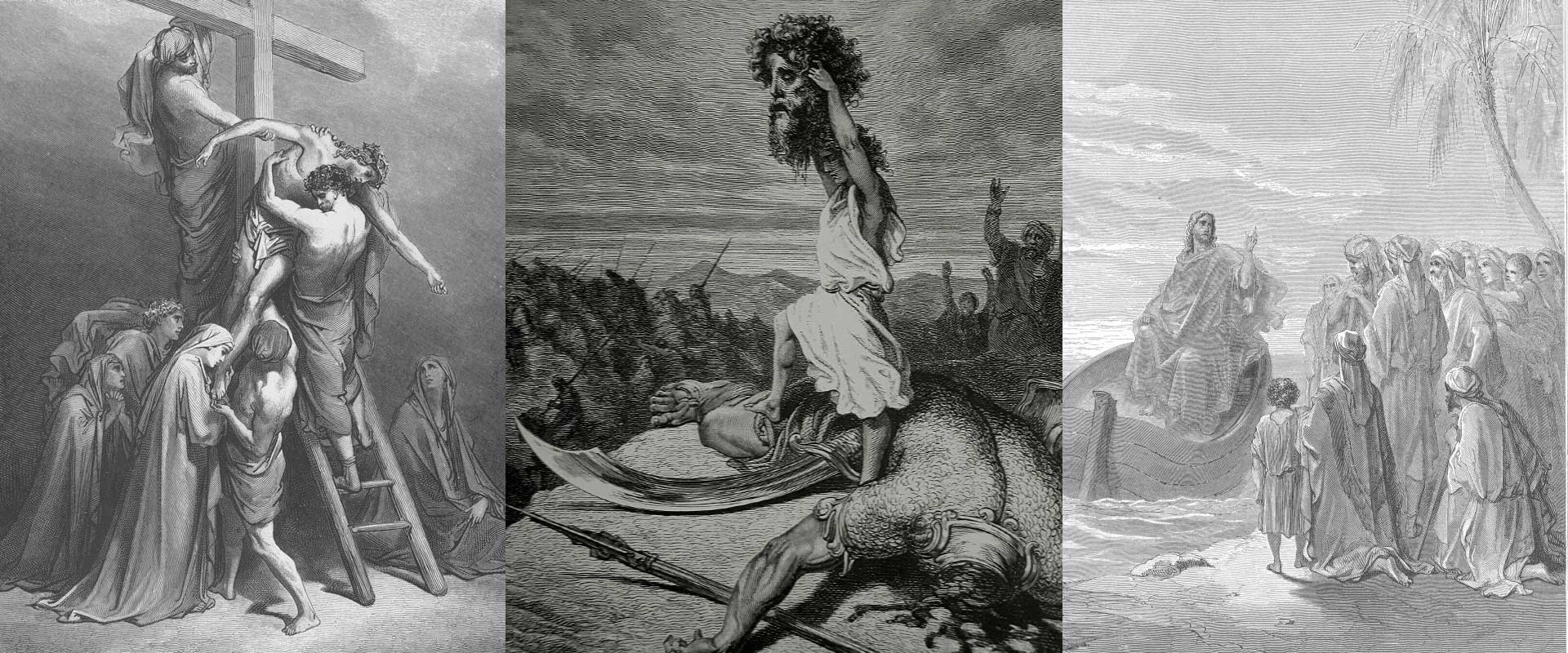When the French artist Paul Gustave Doré (1832–1883) first published his illustrated Bible in 1866, it became one of the most celebrated visual interpretations of Scripture ever created. His engravings, filled with dramatic light, towering figures, and emotional intensity, brought biblical stories to life in a way that words alone could not.
For generations, Doré’s illustrations have shaped how people visualize scenes from Genesis, Exodus, the Psalms, and the Gospels. His work remains a bridge between art and faith, making the Bible’s timeless truths accessible to both scholars and ordinary readers.
This article explores Paul Gustave Doré’s dramatic illustrations of the Bible, tracing their history, themes, artistic style, and enduring influence.
Doré’s Bible: A Landmark in Sacred Art
Doré was already famous for illustrating classics like Dante’s Divine Comedy and Milton’s Paradise Lost. But his greatest triumph came with the illustrated Bible of 1866, which featured over 200 wood engravings.
- It was an instant success in Europe and America, reprinted in multiple languages.
- His engravings became the definitive visual companion for countless families reading the Bible at home.
- Churches, schools, and publishers adopted Doré’s images, embedding them in religious life worldwide.
Today, many of these dramatic scenes are available as Paul Gustave Doré art prints, allowing modern audiences to bring his biblical vision into their homes.
Defining Features of Doré’s Biblical Illustrations
What made Doré’s engravings so compelling was not just their beauty, but their ability to evoke awe and reverence.
1. Mastery of Light and Shadow
Doré used contrasts of darkness and radiant beams to suggest divine presence—God’s hand guiding events, Christ’s glory, or the drama of prophecy.
2. Human Emotion and Drama
Characters were never static. From the sorrow of Job to the triumph of Moses parting the sea, Doré’s figures conveyed raw emotion.
3. Monumental Scale
Many scenes appear larger than life, reflecting the grandeur of God’s plan. Mountains, cities, and angels loom with epic scale.
His dramatic engravings turned the Bible into a living narrative, much like a stage performance captured on the page.
Old Testament Highlights
Doré’s work in the Old Testament captured the epic sweep of Israel’s history.
The Creation of Light
In one of his most famous images, Doré depicted God speaking light into existence. The swirling contrast of darkness and illumination visually proclaims Genesis 1:3.
The Exodus and Moses
His illustration of the Israelites crossing the Red Sea is filled with powerful energy—walls of water tower over terrified figures while Moses stretches out his staff.
David and Goliath
Doré emphasized the courage of young David, standing firm against the giant, making the victory of faith visually unforgettable.
These scenes remind us of God’s strength and guidance, echoed in many Bible verses that define strength, courage and hope.
New Testament Masterpieces
Doré’s engravings of the New Testament are equally profound, capturing both tenderness and triumph.
The Sermon on the Mount
Christ is surrounded by a multitude, with Doré emphasizing His authority and compassion. Rays of light fall gently, highlighting the Sermon’s spiritual weight.
The Crucifixion
Perhaps Doré’s most haunting work, the crucifixion is shrouded in shadows while Christ radiates calm dignity, embodying both suffering and divine victory.
The Resurrection
In contrast, Doré depicts the Resurrection with bursting light and movement, emphasizing triumph over death. This theme connects directly with comforting Bible verses about death and eternal life.
The Impact of Doré’s Biblical Vision
Doré’s Bible engravings were more than art—they were a visual catechism. For people in the 19th century who could not read, these images communicated the power of Scripture in ways words alone could not.
- They shaped sermons, stained glass, and even film depictions of the Bible.
- His work influenced generations of Christian art and devotional imagery.
- Many families passed down Doré’s illustrated Bible as a treasured heirloom.
Even today, Doré’s dramatic vision continues to inspire, as modern believers find strength in combining the Word of God with its visual storytelling.
Comparison of Doré’s Illustrations and Their Themes
| Illustration | Biblical Theme | Doré’s Focus | Impact on Readers |
|---|---|---|---|
| Creation of Light | Genesis 1:3 | Light bursting from darkness | Awe at God’s power |
| Crossing the Red Sea | Exodus 14 | Deliverance and triumph | Confidence in God’s salvation |
| David and Goliath | 1 Samuel 17 | Courage in weakness | Hope and bravery in faith |
| Sermon on the Mount | Matthew 5 | Christ’s authority and compassion | Guidance in daily Christian living |
| Crucifixion | John 19 | Suffering and victory | Reflection on sacrifice |
| Resurrection | Matthew 28 | Triumph over death | Assurance of eternal life |
Conclusion
Paul Gustave Doré’s dramatic illustrations of the Bible continue to stand as one of the most powerful artistic interpretations of Scripture ever created, shaping the way believers imagine the great stories of faith. His engravings—whether portraying the grandeur of Creation, the deliverance of the Exodus, or the triumph of the Resurrection—capture not only the drama of the text but the eternal message of God’s love and redemption. They remind us that art and faith are deeply connected, and that visual storytelling can bring the truths of the Bible alive in unforgettable ways. For those seeking to carry Doré’s legacy into their daily walk of faith, our curated spiritual wall art collection and dedicated Paul Gustave Doré Bible art prints allow you to experience his dramatic vision in your home, keeping timeless biblical scenes as a source of daily reflection and inspiration.
FAQs on Paul Gustave Doré’s Dramatic Illustrations of the Bible
Why are Paul Gustave Doré’s Bible illustrations so famous?
Because they combined artistic genius with emotional power, making Scripture accessible and unforgettable for millions.
How did Doré influence the way people read the Bible?
His engravings acted as a “visual translation” of Scripture, helping readers picture stories in vivid, dramatic ways.
Which biblical scenes did Doré illustrate most powerfully?
The Creation, Exodus, David and Goliath, the Crucifixion, and the Resurrection remain his most celebrated works.
Can Doré’s engravings still inspire faith today?
Yes, their timeless quality continues to move viewers and encourage reflection on God’s Word.
Where can I see Doré’s Bible illustrations today?
Many are available as Paul Gustave Doré Bible art prints and remain treasured for both art and faith.





